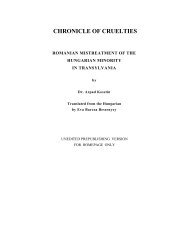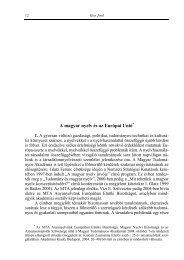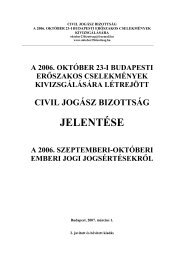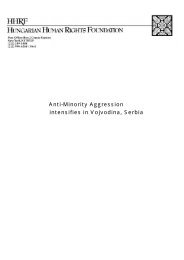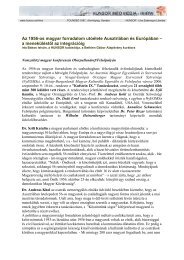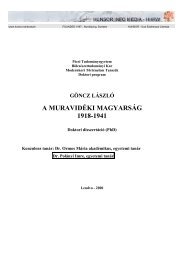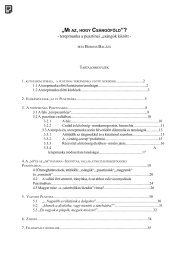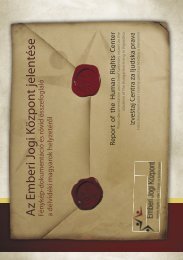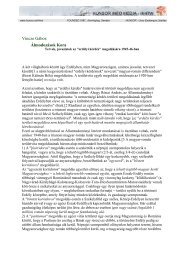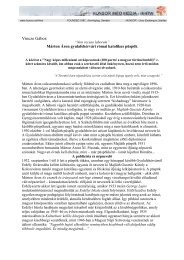and their supporters. On one occasion, after a long investigation, the gendarmerie collected abouttwenty people, including the Orthodox priest, whose son had escaped, after arousing somesuspicion. The Serb suspects were sentenced to death by the summary court.The Roman Catholic Priest, Balint Dupp, appeared before the court and the firing squad sayingthat they should not punish the father for his son's behavior, wich would be a fatal personal andpolitical mistake. "If you execute him, let me be executed too, for there has been friendshipbetween us so far, and the survival of Hungarian Catholics is at stake..."The priest's act caused several hours of confusion within the military justice. There weresupporting telephone calls. The Catholic congregation flocked around their priest, and they hadthe support of the Orthodox population, but it was all in vain. While Dupp was away at thecounty court in Zsablya for further negotiations and ironed out an agreement with Gyula Hazai,the High Sheriff all twenty convicts were executed in Csurog. It is said that a possible prelude tothe Orthodox priest's execution, and a cause of the later vendetta, was the fact that on theHungarian troops' arrival in 1941, the daughter of the same priest went to the commandingofficer, and while greeting him in Hungarian fired at him with a pistol hidden in her bunch offlowers. The brave and fanatical girl was immediately shot dead by the surrounding soldiers.In mid-October, 1944, when the partisans and the vengeful villagers started butcheringHungarians, the Orthodox Serbs defended the Catholic priest from arrest and death,remembering his behavior two years before. In the second week of the slaughter, the son of theexecuted Orthodox priest turned up in Csurog as a Major of the partisans. At once he demandedthe Catholic priest's arrest.He convened the Village Committee for the Liberation of the People, and demanded that thepriest should be executed as "an eye for an eye". The more decent Serbs defended Dupp almostday and night for two days, saying that he had been the one to fight for their priest two yearsbefore. The Major then grew tired of bargaining and the apparently invincible resistance of thelocals, with some military help from Novi Sad, captured the priest and had him taken to theregional center. There, due to his connections, he arranged that the priest was declared a warcriminal and carried109back to Csurog with a death sentence. There the major's partisans executed Balint Dupp in frontof his church, without even blindfolding him.It was not his congregation who maintained the memory of Balint Dupp's lamentable death, butsome better natured old Orthodox men who were ashamed of the deeds of the Serbian villagers.The partisan commander could not gather any Catholics to watch the sight, since those who wereleft alive were walking now with scarcely any clothes on to the concentration camp in Jarek tolie starving on the bloody straw swarming with lice, prey to the deadly typhus. There remainedonly a couple of thousand homeless wretches out of the 3300 Hungarian inhabitants of Csurog.They can no longer be united.ZSABLYAIt cannot be regarded as a mistake that the Serbian list of casualties issued in 1946, knew about72 fewer Serbian martyrs than what the Hungarian Generals and Colonels responsible for thebloodshed were accused of by the Hungarian Chief of the General Staff. (The reason for the
Hungarian retaliation was the partisan activity originating from the Banat, which had elevenHungarian victims: two policemen, seven border guards and two gendarmes.)The Hungarian court laid charge to 653 Serbian victims, while the Serbian indictment referred toonly 581 victims. The extent and ferocity of the retaliation was not diminished by this numericaldifference.The retaliation against the Hungarians started as soon as the Russian troops and the partisansarrived. They began gathering the Hungarians, most of whom were immediately executed on thespot in the most savage and ferocious of ways. Many of the more well-to-do Hungarians, whomthe Serbs disliked, were drowned in the filth of the latrine. Others were beaten, whipped to death,and many of the real or imagined adversaries of the Serbians had their finger nails torn off first.Some victims were dragged to a smithy and burnt with a hot iron. The passion for burning andsingeing naked sex organs increased the partisans thirst for inflicting more pain and passing theintervening time by literally destroying the captives piece by piece.Some of the partisans lost their patience, gave up the pleasures of torture by burning, and floggedthe backs of naked Hungarian men until their skin came off in strips. Those who died duringtorture were buried in the carrion pit.110A father had eight sons executed. The father was killed first, and his sons had to accompany himto the execution in parade step. His youngest son, thirteen years old, refused to march. Thoughbeaten savagely by the murderers, the teenage boy held out and did not do the parade step inspite of the beating. All his brothers were executed one by one. When he was led to his ownexecution, he spit at his guards, who cruelly knocked out his teeth in turn before killing him.Istvan Mate, a Store owner (born 1911), who escaped in a miraculous way, recalls those weeks:"I was living in Zsablya in October, 1944. The partisans invaded the village at 4 p.m.. PeterFekete, a farm worker with seven children, was caught and hanged on a mulberry tree in front ofthe Village Hall, and left there for three days to the horror of the public. The partisanswrongfully blamed him for collaborating with the gendarmerie.I was arrested the same day as Peter Fekete. I was locked up in the village jail. Every daytwenty to thirty people were pushed into the room. They were always questioned and tortured atnight. Peter Fekete's brother was tortured savagely; he died in jail. He said his brother's testicleshad been pulled back with a piece of wire and smashed with a hammer. We took the dead bodiesto the cemetery on carts. I had to dig graves, which were 8 meters long, 4 meters wide and morethan 2 meters deep. Fourteen cartloads of corpse, that is 150 people, were buried in each of thesepits. On the way out, I had to lay on the corpse lest I should get shot. There were thirteen orfourteen year old students among the corpse. The victims were made to undress first and werethen executed with machine guns. I recognized Andras Magyar gendarme, Vida Borcsok innkeeper,Andras Csirpak, a disabled soldier, High Sheriff Bela Bukovary, Peter Kutri, JozsefBorcsok and Janos Borcsok among the corpse; they had all been judges or members of the jury. Iknow about five mass graves in Zsablya."The following is an account of Mrs. Terez Gregus:
- Page 3 and 4:
Library of Congress Catalogue Card
- Page 5 and 6:
Mutilation of the hands or feet wit
- Page 7 and 8:
they wanted to belong. On the annex
- Page 9 and 10:
individuals, then shooting them by
- Page 11 and 12:
the Russians and under their protec
- Page 13 and 14:
22PEOPLE OF BEZDAN1.On a May aftern
- Page 16 and 17:
26that those people all fell victim
- Page 18 and 19:
ack a 13 year-old boy to the soccer
- Page 20 and 21:
Russian officers cursed and told th
- Page 22 and 23:
Jani was set free for he had been a
- Page 24 and 25:
There were some people who, in spit
- Page 26 and 27:
March 12, 1945. The relatives of th
- Page 28 and 29:
Ferenc Csapo, 33 Mihaly Miovacs, 18
- Page 30 and 31: Having heard about the advance of t
- Page 32 and 33: "On November 3, I got up at five in
- Page 34 and 35: The vicar would come every night. H
- Page 36 and 37: hand. Raising it to his mouth, he d
- Page 38 and 39: "24th October, 1944. Yesterday was
- Page 40 and 41: "I have only one chance to be sacri
- Page 42 and 43: The data, which shows that on the s
- Page 44 and 45: all the captured Serbs, as neither
- Page 46 and 47: Before and during World War II, the
- Page 48 and 49: would order fire in an instant. Wit
- Page 50 and 51: Our house looked out over the main
- Page 52 and 53: He had just arrived home after thre
- Page 54 and 55: 28. Jozsef Pasztor, 34 56. Albert G
- Page 56 and 57: The OZNA officer, who exhumed a mas
- Page 58 and 59: 7917 year old Karoly and 8 year old
- Page 60 and 61: 82FROM SZENTFULOP TO THE GAKOVA CAM
- Page 62 and 63: My mother died on January 4, 1946.
- Page 64 and 65: Jozsi, the leader of our committee
- Page 66 and 67: his own grave, then machine gunned
- Page 68 and 69: driving a wheelbarrow on the sidewa
- Page 70 and 71: "Now that's exactly what we needed
- Page 72 and 73: 15 Istvan Polyakovics, Zenta, 18861
- Page 74 and 75: idge was built (from several rows o
- Page 76 and 77: There is a common opinion among the
- Page 78 and 79: The Catholics of the village were o
- Page 82 and 83: "My younger brother, Bandi, was tak
- Page 84 and 85: two young instructors staying in he
- Page 86 and 87: In Tunderes (Vilova) there was no o
- Page 88 and 89: weeks spent starving, laying on str
- Page 90 and 91: 121PACSERAt Pacser sixteen Serbians
- Page 92 and 93: piece of land, there are three rows
- Page 94 and 95: "I understood that through the OZNA
- Page 96 and 97: took the priest under their protect
- Page 98 and 99: "We set off from Hadikliget on Octo
- Page 100 and 101: everyone to the front! The Party us
- Page 102 and 103: 137REPORT OF LOSSESIn addition to o
- Page 104 and 105: 141Source: Zlocini okupatora u Vojv
- Page 106 and 107: well as in words, that there had be
- Page 108 and 109: The American military forces delive
- Page 110 and 111: culpability or participation are th
- Page 112 and 113: The accused did not make use of his
- Page 114 and 115: the spirit of revenge among the Hun
- Page 116 and 117: considered all the claims of Hungar
- Page 118 and 119: The People's Court of Budapest just
- Page 120 and 121: From then on all hell breaks loose.
- Page 122 and 123: Recommended readingeRudolf Kiszlion



